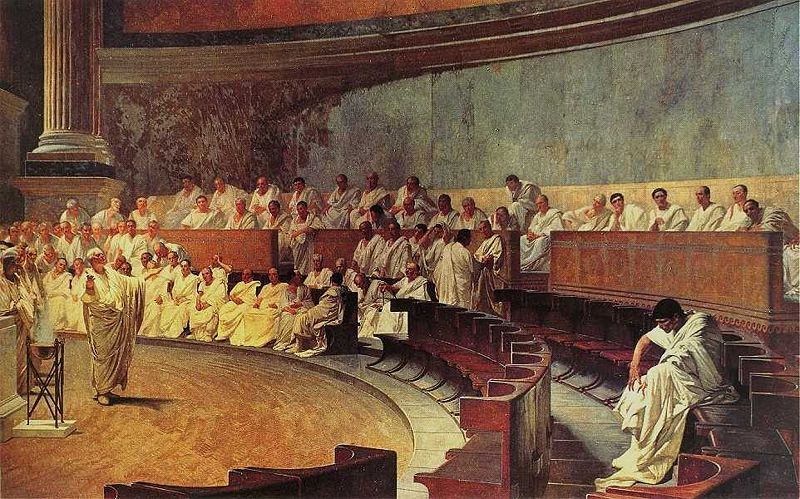
Roman Senate
Initially, Rome was ruled by kings, who were elected from each of Rome's major tribes in turn. The exact nature of the king's power is uncertain. He may have held near-absolute power, or may also have merely been the chief executive of the Senate and the people. At least in military matters, the king's authority (Imperium) was likely absolute. He was also the head of the state religion. In addition to the authority of the King, there were three administrative assemblies: the Senate, which acted as an advisory body for the King; the Comitia Curiata, which could endorse and ratify laws suggested by the King; and the Comitia Calata, which was an assembly of the priestly college that could assemble the people to bear witness to certain acts, hear proclamations, and declare the feast and holiday schedule for the next month.
The class struggles of the Roman Republic resulted in an unusual mixture of democracy and oligarchy. The word republic comes from the Latin res publica, which literally translates to "public business". Roman laws traditionally could only be passed by a vote of the Popular assembly (Comitia Tributa). Likewise, candidates for public positions had to run for election by the people. However, the Roman Senate represented an oligarchic institution, which acted as an advisory body.
In the Republic, the Senate held great authority (auctoritas), but no real legislative power; it was technically only an advisory council. However, as the Senators were individually very influential, it was difficult to accomplish anything against the collective will of the Senate. New Senators were chosen from among the most accomplished patricians by Censors (Censura), who could also remove a Senator from his office if he was found "morally corrupt"; a charge that could include bribery or, as under Cato the Elder, embracing one's wife in public. Later, under the reforms of the dictator Sulla, Quaestors were made automatic members of the Senate, though most of his reforms did not survive.
The Republic had no fixed bureaucracy, and collected taxes through the practice of tax farming. Government positions such as quaestor, aedile, or praefect were funded from the office-holder's private finances. To prevent any citizen from gaining too much power, new magistrates were elected annually and had to share power with a colleague. For example, under normal conditions, the highest authority was held by two consuls. In an emergency, a temporary dictator could be appointed. Throughout the Republic, the administrative system was revised several times to comply with new demands. In the end, it proved inefficient for controlling the ever-expanding dominion of Rome, contributing to the establishment of the Roman Empire.
In the early Empire, the pretense of a republican form of government was maintained. The Roman Emperor was portrayed as only a princeps, or "first citizen", and the Senate gained legislative power and all legal authority previously held by the popular assemblies. However, the rule of the Emperors became increasingly autocratic, and the Senate was reduced to an advisory body appointed by the Emperor. The Empire did not inherit a set bureaucracy from the Republic, since the Republic did not have any permanent governmental structures apart from the Senate. The Emperor appointed assistants and advisers, but the state lacked many institutions, such as a centrally planned budget. Some historians have cited this as a significant reason for the decline of the Roman Empire.
The Roman Constitution was an uncodified set of guidelines and principles passed down mainly through precedent. The Roman constitution was not formal or even official, largely unwritten and constantly evolving. Concepts that originated in the Roman constitution live on in constitutions to this day. Examples include checks and balances, the separation of powers, vetoes, filibusters, quorum requirements, term limits, impeachments, the powers of the purse, and regularly scheduled elections. Even some lesser used modern constitutional concepts, such as the bloc voting found in the electoral college of the United States, originate from ideas found in the Roman constitution.
Over the years, the Roman constitution continuously evolved. By 573 BC, the Constitution of the Roman Kingdom had given way to the Constitution of the Roman Republic. By 27 BC, the Constitution of the Roman Republic had given way to the Constitution of the Roman Empire. By 300 AD, the Constitution of the Roman Empire had given way to the Constitution of the Late Roman Empire. The actual changes, however, were quite gradual. Together, these four constitutions formed four epochs in the continuous evolution of one master constitution.

Roman Senate